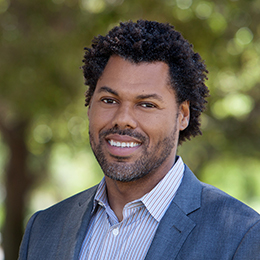

Andrew Curran
William Armstrong Professor of the Humanities, Wesleyan University

Sidney Chalhoub
Professor of History and of African and African American Studies at Harvard University

Brian Lowery
Professor of Organizational Behavior, Stanford Graduate School of Business
This conversation took place on January 4, 2021
Summarized Transcript
Brian Lowery: Where does race come from; when was it constructed?
Andrew S. Curran: The race that we’re thinking about starts primarily in the 17th century in Europe, and that can be attributed to several things. First, the breakdown of biblical understandings of the human condition. For a long time, people thought that the Bible would explain exactly where people came from. But as people started questioning the Bible, different things became imposed on what we call “proto-anthropological” explanations of humankind. At first, there were anatomical explanations. Then we saw the first genealogical explanation, where we started looking at humankind in a way that doesn’t correspond to the Bible. Ultimately, we saw classificatory explanations toward the end of the 18th century. One of the big things happening during the 17th and 18th centuries was that scientific explanations of humankind were supplanting biblical explanations, and that allowed naturalists, analysts, and classifiers to start looking at the human species in a very different way. People looked at human differences and human groups in terms of varieties, which was a botanical metaphor. As we moved toward the 18th century, the word “race” began to be used much more often. This was a “zoological” explanation, which reduces people to a particular lineage and certain logic.
Brian Lowery: Are you saying that changes in religion are responsible for our current understanding of race?
Andrew S. Curran: Yes, and to give a specific example, I want to talk about an explorer named François Bernier, who could see different human phenotypes when most people could not. He was the disciple of one of the great empiricists of the 17th century. (Empiricism is a belief that emphasizes the role of observation in drawing conclusions from natural phenomena). In 1684, he came up with the revolutionary idea that there were separate species of people. But at the time, he faced a lot of backlash because people believed that humankind was not subject to the same rules as the animal kingdom; humans were thought to be a special group that was separate from animals.
Brian Lowery: Did the construction of race affect the development of science?
Andrew S. Curran: There’s a dialogue between science and the construction of race, and race certainly informs a lot of it. I think that the idea of “the accident” is critical in understanding where race comes from. For a long time, “accidents” simply didn’t happen in nature. But when proto-scientists or naturalists started to think there was a possibility of things going wrong, that God may not be responsible for all phenomena, people began to believe that the human race could have its own story. And when the human race started to have its own story, people began to rethink humankind’s genealogical explanation. The big explanation that arose during this time, which ended up having a significant effect on science, was “degeneration”: the idea that there was an original white prototype that moved out into different regions of the world and “degenerated” as a function of climate or food. That was one of the big things that changed the way people thought about human beings. This theory was actually the reverse of the “Out of Africa” model that we now know is the actual explanation for humankind.
Brian Lowery: What’s the relationship between this degeneration hypothesis and slavery?
Andrew S. Curran: To begin with, the fact that Europeans had been enslaving Africans starting in the 15th century had an enormous impact on knowledge. During this time, bizarrely enough, the justification for slavery was based on religious criteria and not scientific arguments. Only in the 1770s, when people started questioning the slave trade, did the pro-slavery people take all the information floating around for centuries and marshal it into incredibly racist, pro-slavery arguments. Racial ideas had existed for a long time, but they were the ones who took it and turned it into a real ideology.
Brian Lowery: How do you think slavery affected the further development of race and the Europeans’ perception of themselves?
Andrew S. Curran: In the 17th century, racial ideas were coming not only from scientists but from what we call the “colonial laboratory.” For example, Barbados was the first place in the Caribbean where slave laws were created in a way that began to develop categories between people. They weren’t racial, necessarily, but they separated people in a very particular way: whites were free and Christians; Blacks were heathens and slaves. This information was carried over to Europe. Whereas previously, people received information about Africans from travel logs to Africa, in the 17th and 18th centuries, much more of that information started flowing from the colonies. The paradigm of Africans being Caribbean slaves became much more important than the Africans written about in travel logs. The stories of autonomous Africans working in agriculture or creating metal sculpture, for example, all went away. They were supplanted by a vision of Africans that reduced them to slaves.
Brian Lowery: How did the information coming out of the colonies, as Andrew talked about, affect the development of the concept of race?
Sidney Chalhoub: One keyword regarding racialization is “slave emancipation.” The Haitian Revolution caused many changes, including a rise in the anti-slavery social movements at that time. The 19th century brought about a paradox of an increase in slavery in the U.S., Brazil, and the Spanish colonies, but also a rise in the political discourse against slavery. Racializing became a key factor in the politicization of slavery. The justification for the continuation of slavery took on different shapes before slave emancipation became a big issue. The politicization of labor, and initiatives against forced labor, went beyond the type of slavery that existed in the European colonies.
Brian Lowery: What exactly happened in the Haitian Revolution, and how did the politicization follow from that?
Sidney Chalhoub: Haiti was a lucrative French colony, and when the French Revolution occurred, the slaves in Haiti took it to mean that there would literally be freedom for all — themselves included. This originated a long period of wars beginning in the early 1790s, which resulted in them finally receiving independence in 1804. Symbolically, the Haitian Revolution represented a fear of apocalyptic uprisings of enslaved people everywhere; even in the years after the Haitian Revolution, police in Rio de Janeiro continued to arrest Africans who had any signs of or allusions to the Haitian Revolution. The symbolism of the Haitian Revolution became much bigger than the actual Haitian Revolution itself because of its political importance throughout the 19th century.
Brian Lowery: What was the effect of the Haitian Revolution on Europe?
Andrew S. Curran: Before 1804, France largely relied on Haiti to be its “cash cow,” as Haiti was the most profitable colony in the world. But when the Haitian Revolution occurred, ports along the French coast, which had been supplying lots of slaves, shut down, Bordeaux in particular. There were enormous financial consequences that happened because of this. The Haitian Revolution inspired people to produce a new, horrific raciology that had not existed before. This was informed by a vision of a terrifying, uncivilized African, who is part of a different species entirely. There was a shift from monogenesis — the idea of one human race — to polygenesis, the idea that humans came from separate origins. Julien-Joseph Virey and many other people around 1804 began to push this second kind of vision, and it became much more important around that time. By having a separate, polygenetic explanation of humankind, it was easy to justify different kinds of treatment. This notion would become very important for the American pro-slavery lobby, who would grab hold of polygenesis and make it a parcel of their worldview. It’s probably in the arsenal of the alt-right today as well.
Brian Lowery: What are the significant differences in how race is understood across countries, and how did we come to that point?
Sidney Chalhoub: We need to start with the fact that slavery was a very different institution in different countries. For example, 5 million of the 12 million people transplanted from Africa and enslaved went to Brazil alone. The number of enslaved Africans that went to the U.S. is closer to 400,000. The demographics of slavery in these two societies were enormously different; even today in Brazil, 56% of the total population self-identifies as of African descent, a drastically different statistic from the U.S. Brazil was the second-largest “African nation” in the world, only behind Nigeria. That meant that slavery, too, had a different demographic. In Brazil, slavery was a national institution in the sense that it was uniformly present in the whole national territory. Additionally, urban slavery in Brazil also played a vital role. In Rio de Janeiro, for example, 110,000 out of a population of 260,000 were enslaved in 1849. More than 60% of these 110,000 people had been born in Africa. In contrast, New Orleans never had more than 15,000 slaves and other places in the Caribbean never approached Rio de Janeiro’s number of slaves. Urban slavery depended on the slave trade, and high mortality and manumission rates meant that the labor force needed to be constantly resupplied. The only national census from Brazil during that period (taken in 1872, almost two decades before the end of slavery) showed that three out of every four people of African descent were already free. Manumission was very important for the social control of slaves. An enslaved person in Brazil would usually know fellow enslaved people who eventually became free during their lifetime and had families with children born into freedom. Simultaneously, though, there were high death rates and a very tense African trade; people were being constantly kidnapped and brought into coffee and sugar plantations, where slaves worked all over Brazil. If we use the word “slavery” to generalize this labor system and this institution all over the Americas, we are making a big mistake. There are some commonalities, such as the fact that these were all people who were seen as property and bought, sold, and used like any other property transaction. However, grouping them all under the same term makes it difficult to understand how different racial ideologies emerged in these nations and neglects to look at the demographics, the difference in the presence of people of African descent in these different places, and the difference in how slavery was organized and functioned internally. For example, manumission was irrelevant in the South of the U.S. but was vital to social control in Brazilian slavery.
Brian Lowery: How was the distinction between those who were enslaved and those who were free maintained in Brazil? In the U.S., there were also free Blacks, but we understood race as being the notion that if you appeared Black in any way, shape, or form, you were always at threat to be enslaved. How did that operate in Brazil — were free Africans not considered “Black” anymore, or was being Black not tied to slavery?
Sidney Chalhoub: This is a fundamental and challenging question, and it’s the starting point to thinking about why in Brazil, “race” became a term that described a large vocabulary of ways to describe a person’s skin color and includes dozens of shades in between “Black” and “white.” How we describe someone has a lot to do with the type of interaction we have with that person, and how that person is judged in terms of their “color” is going to approximate whether that person is in danger of being enslaved or is seen as a free person. There was a constant exercise of attributing meaning to people’s skin color. For example, in the urban situation, police profiling was seen as extremely important because, in a city like Rio, the police supported slaveholders to maintain slave discipline and control. All these details and strategies for keeping the slave labor force under control were essential for developing ideas about race in people’s daily lives from the bottom up. Racializing on the ground is crucial for understanding how racial ideologies emerged among elites and in state policies. In other words, the dynamics on the ground help us understand national concepts of race.
Brian Lowery: Andy, your description of the construction of race is one of biological essentialism: Race, or what one “looked like,” was a way of assessing what they were biologically. How does maintaining this idea of biological essentialism work once people start seeing an array of color shades that isn’t just “Black” or “white”?
Andrew S. Curran: There were, on the one hand, these reified categories of race, which existed in classificatory schemes. However, the categories often don’t correspond or live up to the social or biological reality of what we call race now. Indeed, in the French context, we saw that quite a bit, because there was much more miscegenation taking place in those colonies than in the British colonies. It’s interesting to juxtapose their different ways of dealing with Africans. The French enforced baptism on enslaved people, whereas they did not want to baptize the slaves in the British context because they did not want to admit that Christians were enslaving Christians. In the French context, their reasoning for this was that these people would be giving up their body but gaining eternal salvation in return. That was one of the things that allowed a different view of race on the ground in the French colonies, which resulted in an enormous class of people who were of mixed race who were able to be sent to France to be educated, become property owners, and then would go back to the colonies to run plantations. The palette of colors and political possibilities is very different in different spheres and colonial contexts.
Sidney Chalhoub: In Brazil, in the second half of the 19th century, the question of mixed-race people was a significant intellectual challenge. These white thinkers were mesmerized by European intellectuals and reading racist theories that said that racial mixing destroys the generation and there is no future formation based on racial mixing. They had to reinterpret these European theories so that miscegenation would eventually be something that would be promising for the future. Of course, they still ended up with racist theories, but this was racist theorizing that came in response to the type of theorizing about miscegenation and racial mixing that the European racists were popularizing at the time.
Brian Lowery: The way race operates in the U.S. is very different from how it operates in Brazil. What are the consequences of social solidarity with constructing a racial identity that’s meaningful to the people who see themselves as Black in Brazil vs. the U.S.?
Sidney Chalhoub: One crucial element in creating solidarity and community in African Brazilian communities was African religions and their adaptations on the ground. They were tolerated to some extent, but it depended on the period and the region where they were in the country. But they could not have these religions shown or practiced explicitly or publicly, so they would be practiced in the backyards of houses, and they could not have any public facet to it. Communities of people of African descent were, in many ways, removed from public awareness. People had to be careful in their everyday interactions; Catholicism could protect you, but if someone’s religion was of African descent, it had to be kept hidden. People were forced to assume a split social identity in order to negotiate their daily lives. This didn’t change until the myth of racial democracy picked up in the 1930s.
Brian Lowery: In the U.S., there has been a sense of optimism about race for the last 10 years. In part, this is because there has been an increase in interracial marriage. People think that race won’t be an issue in the future because we will all be mixed. What does the history of the construction of race tell you about that? Is that something you would be optimistic about?
Andrew S. Curran: The construction of race is fascinating because, on one hand, we recognize that race as a biological entity must be completely done away with. At the same time, it is essential to preserve race as some kind of functioning tool for us to sort out the errors of the past. It’s been a good 10 years in some ways and a terrifying 10 years in other ways. As a country, we slid back to some terrifying patterns from the 18th century that we thought we had done away with entirely in the discourse of the alt-right. It’s also a very complicated time when it comes to questions of racial authenticity and DNA; DNA testing is giving people funny notions of who they are based on their genomes.
Sidney Chalhoub: Race has been completely deconstructed as a scientific concept. However, we need to remain vigilant because there is medical research that seems, sometimes, to give race a role that it should not have. History shows us that there is no relation between racial mixing and having a more “just” society in racial terms. Racial mixing in Brazil has been going on for forever, but racism is much worse in Brazil than it is in the U.S., especially in terms of police violence against people of African descent. I don’t see any relation between racial mixing and a better future. On the other hand, we are dealing with the fact that it remains incredibly strong as a historical construct and a social fact. Once we get rid of race as a scientific concept, the need for our society to address the social injustice that has been constructed will be so much more acute. Socially, we need race more than ever now because we need to be in a position to undo what race has done over time. This is a strange situation in which there is no reason to believe in race biologically, but we have more reason to value race socially.
Brian Lowery: What do you envision as the way forward if you wanted a more just society?
Andrew S. Curran: My small contribution in this area will not be in public policy, even though I participate in that, but in talking about where race came from to begin with. By constructing the overall history of race, it will allow people to realize that the story and the foundation for race is spurious. This is one of the great unknown stories, and people still don’t understand it. It’s something that is never taught in schools and rarely taught in universities. I’ve taught a “History of Race” class on several occasions with 60% students of color. Students find it so relieving to find out that this is just a massive sack of lies constructed for bizarre anecdotal reasons from the 17th and 18th centuries. That’s where I’m going to work, and I certainly hope that the new administration will be addressing some of the things that we’ve been talking about as some of the consequences of the history of race tonight.
Brian Lowery: I agree with you that the construction of race has been a sack of lies, but that argument is also now being used against an attempt at justice. How do you both work against the concept of race while simultaneously accepting the social reality of the injustice and working against that?
Andrew S. Curran: That’s a Kwame Anthony Appiah conundrum; he denied the existence of race, and then later on was forced to recant that belief and say that we need to use this tool to help us deal with injustice. That’s one of the big problems in France right now — France has always said that race doesn’t exist as a concept, and they don’t do the same kind of census work or use the same categories that the United States does. And now, they’re being ripped apart for a lot of the same reasons the U.S. is being ripped apart. There’s a big movement in France to work on addressing these things through the existence of racial categories, which theoretically do not exist.
Sidney Chalhoub: Theories that are based on false assumptions still have a very concrete history. Any arguments used to naturalize human differences and to create hierarchies are necessarily based on some kind of fiction; race is one example among many. However, we should also assert that the falsity of this concept is just as strong as the history behind it and the concrete realities it has created. The basis for our racializing now — for example, coming up with social policies to address historic injustices — must be asserted as strongly as the falsification that race represents as a concept. We need to destroy the falsification, but a historical work can only be undone through political struggle. Our future political struggles involve having strong enough affirmative action policies to undo injustices in many areas. In Brazil, affirmative action has shown to be extremely successful. Before, university classes would be filled with 100% white students, the diversity among the students now exactly replicates the demographics — more than 50% of them are of African descent. Affirmative action policies are effective; they do bring about change. And I don’t see any other way of undoing what history has done.
